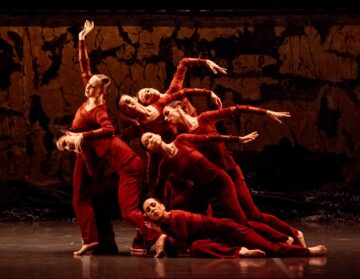by Dick Edelstein

On account of the mood of economic restraint that looms over opera productions, preventing Barcelona’s Liceu from programming as many operas per season as it did just a couple of decades ago, each season now more often includes other orchestral works that feature singing, dance or theatre. And this effort, born of necessity, to engage the public in new trends in the performing arts has proved so successful that the non-operatic works often attract greater attention than the operas. Clear examples this season have been theatre director Romeo Castellucci’s revolutionary staging of Mozart’s requiem and a performance of two Gluck ballets organized and directed by the popular Catalan early music conductor Jordi Savall. Both of these events attracted as much public attention as the season’s operas.
Barcelona’s importance as a hub for performing arts in the Northern Mediterranean region was evident last March when Savall brought the Ballet de l’Opéra National du Capitole from Toulouse to the Catalan capital to perform the Gluck ballets, which were co-produced in collaboration with the Théâtre National de l’Opéra-Comique de Paris and elegantly supported by Le Concert des Nations, Savall’s talented, multi-national period instrument orchestra. Savall is well known for his work in bringing baroque and other styles of early music to audiences in Spain, France and throughout the world, and in this case the regional synergy involved was evident. While Barcelona’s Gran Teatre de Liceu is an emblematic opera house with great international projection, unlike the Théâtre du Capitole in Toulouse, it does not have its own ballet company.
When Jordi Savall puts on a musical performance of any sort—whether as a virtuoso performer on the viola da gamba or as a conductor—he is sure to attract great public attention. On this occasion, he complemented the historical interest of Gluck’s ballets with superb performance values and the unique musicianship of his orchestra featuring period instruments. The performance of the two ballets by Christoph Willibald Gluck, Semiramis and Don Juan, was scheduled as part of the 8th edition of Dansa Metropolitana, a contemporary dance festival held in 12 cities and towns in the Barcelona metropolitan area.
These two pieces are important examples of works that transformed the art of ballet in the 18th century. They were the result of a collaboration between Gluck, the librettist Ranieri Calzabigi and the choreographer Gasparo Angiolini. At the time, these three artists were, in their different ways, all dissatisfied with the prevailing focus in ballet on technical brilliance, elaborate costumes and ornamentation to the detriment of dramatic intensity and more human and expressive values. Both works generated considerable controversy and marked a shift towards ballet as a more serious art form.
The new choreographies for Semiramis by Ángel Rodríguez and Don Juan by Edward Clug interpreted Gluck’s 18th-century compositions in a contemporary style based on a fusion of modern gestures and more traditional ballet forms. In a Barcelona debut that was well received by the local audience, Rodríguez interpreted Gluck’s dramatic music in a suite of abstract episodes that were not directly based on the legend of Semiramis or the original scenario based on a play by Voltaire. At one point in the performance, thanks to a quick off-stage costume change, the male dancers could be more easily distinguished from their female counterparts, but eventually the female dancers’ attire was changed to match, further blurring the distinction between male and female roles that is so typically emphasised in classical ballet.
In the second piece, Romanian choreographer Edward Clug offered the audience a personal interpretation of the character of the famous libertine Don Joan, accompanied by his servant Sganarelle and by Donna Elvira, a damsel seen by the protagonist as an object of seduction. Although previously unknown to Barcelona audiences, Clug, who developed his craft amidst the difficulties and cultural isolation of the terrifyingly rapacious Ceaușescu regime, was received with great acclaim.
Music fans, not just in Spain or France but in Europe and beyond, rely on conductor and viola da gamba virtuoso Jordi Savall to entice them with the often overlooked charms of early music, and the interest he has shown in Gluck is a case in point. On first hearing, Gluck’s music may not sound as inventive or as interesting as that of immediate successors like Mozart and Haydn, but the steady pulse of his music forms a great basis for choreography, and Savall brings out the best in Gluck with these performances. The rock-steady rhythms and carefully modulated tempos are not merely fortuitous features of Gluck’s music for ballet. In his time, he acquired a considerable reputation for recognising and bringing to life the dramatic possibilities of music, both in opera—where he was seen as a great innovator— and in ballet.
Gluck wrote his Don Juan in 1761, just before he created his well-known opera Orfeo et Euridice the following year. The ballet, although controversial because of its novelty, was a great success, deemed revolutionary in the same way as his operas, and his innovations had a great impact on the development of music for ballet and opera.
Jordi Savall is a regional force all by himself and is particularly well known in France, where he has won prizes and honours and released a number of recordings. Savall is a great counterexample in an era where culture and identity can be viewed as instantaneous and momentary values, where people buy fashion items of the moment in low-cost shops only to discard them at the end of the season, and where some members of recent generations who may not know who Billie Holiday is, are able to download the latest track by Charli XCX with a single click. But Savall helps us to remember that the past matters, crucially because who we are very much depends on who we were.
Don Juan. A ballet by Christoph Willibald Gluck at the Liceu in Barcelona.
